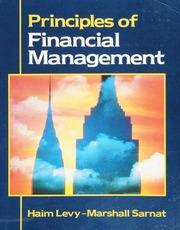Question
Just need a summary as to why Warren Buffett does not run a mutual fund. Why Warren Buffett Does Not Run A Mutual Fund Ever
Just need a summary as to why Warren Buffett does not run a mutual fund.
Why Warren Buffett Does Not Run A Mutual Fund
Ever wonder why Berkshire Hathaway is a corporation rather than a mutual fund? As a corporation, Berkshire Hathaway Inc. is subject to the corporate tax whereas a Berkshire Hathaway mutual fund would not be. Here are three good reasons why Warren Buffett prefers to pay the corporate tax rather than become a mutual fund.
First: A mutual fund's investments have to be marked to market every day
People buy and sell shares of Berkshire Hathaway every day without thinking twice about whether the price reflects their pro-rata share of the company's assets. Berkshire Hathaway's stock price is whatever a buyer and a seller agree to.
When you buy or sell shares of a mutual fund, the mutual fund is on the other side of the transaction. The mutual fund is required to give you a price that is within one penny per share of your pro-rata portion of the mutual fund's assets. If the mutual fund had $10 million in assets, and 1 million shares outstanding, it is required to buy or sell its own shares at $10.
This sounds innocuous, until you realize that it means the fund can pretty much only invest in things that can be priced at the end of each day. There is a little wiggle room here because the mutual fund's price can be rounded to the nearest penny. This means the fund manager can have a small investment in something that is not priced every day. But it can never become so large that it could affect the fund's value by more than a penny a share.
If Berkshire Hathaway was a mutual fund, Buffett may not have been able to buy entire companies like See's Candy, Precision Castparts, and many others simply because after they were acquired, they ceased to have a daily closing price.
Second: Mutual funds usually cannot take a controlling interest in a company
When Buffett first invested in Coke, the company's market cap was $20 billion. Buffett realized that Coke's brand, which was not on the balance sheet, was being significantly undervalued because he estimated it would cost more than $100 billion to create it. By investing in Coke, Buffett figured he was buying a $100 billion asset for $20 billion.
If the investment did not go the right way, Berkshire Hathaway, Inc. could take a controlling interest in the company so he could do something with Coke's brand value to help him recoup his investment. This backup plan, which he never had to implement, gave him a significant margin of safety.
However, if Berkshire Hathaway was a mutual fund, it probably would not be permitted to take a controlling interest. So, in the worst case scenario, Coke's brand value would offer no margin of safety.
Would Buffett have made the investment if Coke's brand value was not able to provide the margin of safety that it did? Maybe, but its likely that he would have made a smaller bet.
Third: Mutual funds have to list the kinds of securities in which they can invest
In the midst of the 2008 financial crisis, Buffett invested $5 billion in perpetual preferred shares of Goldman Sachs paying a 10% annual dividend with attached warrants to purchase 43.5 million shares of Goldman Sachs at $115.
Every mutual fund prospectus lists the kinds of securities in which the fund will invest. No prospectus is so broad as to allow investing in everything. Since these securities were pretty much custom tailored to meet Buffett's requirements, it is doubtful that any mutual fund would have been able to invest in them.
At best, a mutual fund would have to amend its prospectus after the deal was hashed out, but before it could be completed. This kind of change to a mutual fund prospectus would almost certainly have resulted in at least one back and forth with an SEC reviewer and perhaps even required a shareholder vote. It would have taken three to nine months to make the change effective.
After all that, a mutual fund would only be able to put a very small percentage of its assets into these securities because they did not trade on an exchange so there was no market closing price each day.
Step by Step Solution
There are 3 Steps involved in it
Step: 1

Get Instant Access to Expert-Tailored Solutions
See step-by-step solutions with expert insights and AI powered tools for academic success
Step: 2

Step: 3

Ace Your Homework with AI
Get the answers you need in no time with our AI-driven, step-by-step assistance
Get Started


